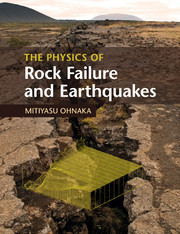Description
The Physics of Rock Failure and Earthquakes
Author: Ohnaka Mitiyasu
This book provides a deeper understanding of earthquake processes, based on laboratory-derived physical laws and formulae, for researchers, professionals and graduate students.
Language: English
Subject for The Physics of Rock Failure and Earthquakes:
Approximative price 44.52 €
In Print (Delivery period: 14 days).
Add to cart
The Physics of Rock Failure and Earthquakes
Publication date: 03-2018
Support: Print on demand
Publication date: 03-2018
Support: Print on demand
Approximative price 85.89 €
In Print (Delivery period: 14 days).
Add to cart
The Physics of Rock Failure and Earthquakes
Publication date: 04-2013
279 p. · 19.2x25.2 cm · Hardback
Publication date: 04-2013
279 p. · 19.2x25.2 cm · Hardback
Description
/li>Contents
/li>Biography
/li>
Despite significant advances in the understanding of earthquake generation processes and derivation of underlying physical laws, controversy remains regarding the constitutive law for earthquake ruptures and how it should be formulated. Laboratory experiments are necessary to obtain high-resolution measurements that allow the physical nature of shear rupture processes to be deduced, and to resolve the controversy. This important book provides a deeper understanding of earthquake processes from nucleation to their dynamic propagation. Its key focus is a deductive approach based on laboratory-derived physical laws and formulae, such as a unifying constitutive law, a constitutive scaling law, and a physical model of shear rupture nucleation. Topics covered include: the fundamentals of rock failure physics, earthquake generation processes, physical scale dependence, and large-earthquake generation cycles. Designed for researchers and professionals in earthquake seismology, rock failure physics, geology and earthquake engineering, it is also a valuable reference for graduate students.
1. Introduction; 2. Fundamentals of rock failure physics; 3. Laboratory-derived constitutive relations for shear failure; 4. Constitutive laws for earthquake ruptures; 5. Earthquake generation processes; 6. Physical scale dependence; 7. Large earthquake generation cycles and accompanying seismic activity; References; Index.
Mitiyasu Ohnaka has been a Professor Emeritus at the Earthquake Research Institute (ERI), University of Tokyo, since his retirement in 2001. Previously, he worked at the ERI in the fields of rock physics, experimental seismology and the physics of earthquakes, from 1970 onwards, as well as holding various positions such as Honorary Professor at University College London, and invited lecturer or visiting scholar at many worldwide institutions, including the Kavli Institute for Theoretical Physics at the University of California, Santa Barbara. Professor Ohnaka also worked widely in Japan, supervising researchers and students, and delivering undergraduate and postgraduate lectures, at institutions from the University of Tokyo to Yamagata University and more. He is the co-author of The Physics of Earthquake Generation, Earthquakes and Faults and The Role of Water in Earthquake Generation (these three in Japanese) and Theory of Earthquake Premonitory and Fracture Processes (1995). Professor Ohnaka was Executive Committee member of the International Association of Seismology and Physics of the Earth's Interior (IASPEI) from 1991 to 1995, and also Chair of the Sub-Commission on Modeling the Earthquake Source from 1991 to 2001 in IASPEI. He is a member of the Seismological Society of Japan and the American Geophysical Union.
© 2024 LAVOISIER S.A.S.
These books may interest you

Rock Mechanics and Rock Engineering 181.72 €



